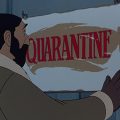Quarantine Control #39: Hilda, the Dawn of Justice, and 102 Minutes

This is the last Quarantine Control entry of 2020, being posted on the very last day of 2020. It cannot be emphasized enough how much of a living hell this year was. The pandemic killing thousands upon thousands a day is only part of the reason for this, but the actions that have happened as a result are another part, particularly in a country where it’s out of control like the United States of America. It’s not as if the country doesn’t have the means to protect its citizens; it’s simply ruled by people who don’t care to, and other people easily fooled by propaganda who think those rulers are looking out for them. Even if there’s a vaccine on the way that’s being slowly distributed, it’s a damning indictment of the US and Americans.
Anyway, we watched stuff. Distractions are necessary, however fleeting.
Joseph Daniels
Well, that about does it for 2020. I think I speak for all of us when I say, I will not be sad to have this year behind me. Personal projects may have borne some fruit this year, but the overall state of the world is one that I could do without. I’m definitely eager for this pandemic to be over, although that’s not going to stop stupid people from being stupid, I guess. Hopping through another Narnia-style portal is looking really good right about now.
Although it’s just an arbitrary changing of the calendar, I hope 2021 is a much better year for everyone than 2020 was. To see the year out, here’s my media recommendation for this week.
Hilda (2018)
Source: Netflix
Episodes: 26

I’ll say it up front: if you’re hoping that the series keeps the style of the first two episodes, you’ll be very disappointed. That said, the first three episodes are based on books in a graphic novel series and are very well written, since they’re based on existing source material. You may find the episodes based on original ideas to vary wildly in quality, which is a tragedy since the graphic novels are very imaginative and full of fantasy and wonder.
Watching Hilda, I started thinking about Star Trek: Discovery. Like Discovery, Hilda’s first two episodes are there to serve as a prologue and aren’t really what the series is all about. It isn’t until the third episode before we start to transition into the proper series, and the fourth episode finally brings all the elements of the Hilda television show together.
I suppose shows like Hilda are made specifically to be binged and not really to be watched once a week. And with a show like Discovery, when you’re being made for a streaming service, maybe there’s room to experiment. The Discovery itself isn’t even in those first two episodes, in contrast to prior Star Trek shows where the entire premise is set up within the first hour, even in the two part pilots. We don’t have to wait until part two of Caretaker to see the USS Voyager in space, for example.
And yet, despite the series that Hilda turned into, I kind of would rather have had an entire season like the first two episodes (and the third episode, that one was pretty good). That’s not to say it’s all bad. I mean, I am recommending it, and even among the episodes cut from whole cloth, there are some pretty good stories, but I still feel like the show could’ve been a bit better.
Anyway, I guess Hilda is the perfect metaphor for 2020. There were some pretty good bits of the year, but I feel like it could’ve been a bit better. Happy New Year, everyone.
Geoffrey Barnes
Batman v Superman: Dawn of Justice — Ultimate Edition (2019, though originally 2016)
Source: HBO Max
Episodes: 1 long movie

A necessary question popped up in my head before diving into Batman v Superman: Dawn of Justice — Ultimate Edition: Do I really want to watch this? After all, impressions of the theatrical release from critics were far from good, and fan reviews weren’t much better outside massive and very vocal fans of director Zack Snyder. The Ultimate Edition was the only version on HBO Max after it replaced the original over the summer, which clocked in at just over three hours thanks to the restoration of 31 minutes of scenes cut from the original. This thing is as long as Avengers: Endgame and apparently not as good. Did I really want to spend my time watching this? Unfortunately, there’s a part of my brain that feels I need to consume every nerd movie I can with my free time, so I just had to. Fortunately, though, I didn’t think it was too bad.
The movie takes place in a world that largely exists between Metropolis and Gotham City that’s become leery of having a powerful so-called protector like Superman living among them, following the events of Man of Steel. It’s a clear setup for the eventual fight between two popular superheroes. The main villains of the movie are involved in weapons trafficking, which, to no surprise, includes Lex Luthor and Lexcorp. But the movie also needed to make time to develop the rivalry between its title characters, which starts when Clark Kent is working on a story for the Daily Planet that casts skepticism on Batman’s form of vigilante justice. These are two deep subplots with several important characters that need to be told, hammering home the necessity for a three-hour film.
BvS establishes its tone as one different from several other superhero films (read: The Marvel Cinematic Universe movies) early on, presenting a darker story that takes inspiration from Frank Miller’s better Batman stories. It doesn’t work too badly. Superman foils a weapons deal about to take place early on, but in a way that exacerbates skepticism that already exists in Metropolis about his powers. One of the biggest skeptics just happens to be Bruce Wayne, further boiling the simmering rivalry between them.
The aspects that deal with the weapons smuggling and the battle between Batman and Superman are largely entertaining to watch. The theatrical version of the film reportedly (I haven’t seen it and don’t plan to) cut a bunch of important context, which made the story too difficult to follow. This movie restoring them makes the story intriguing and entertaining to watch unfold… for a while. The last one-third of the film features a massive fight reminiscent of several other comic book films, as if the movie needed to have one big showcase of what the superheroes involved are capable of. (Let’s be honest: For the massive moviegoing audience, it probably did.) The structure is reminiscent of The Wolverine, a movie that embraced film noir tropes unique for a comic book film that ended on a disappointingly traditional note.
The story is okay, but the actors really shine. Henry Cavill is as good as Superman/Clark Kent here as he was in Man of Steel. But I was impressed than I thought I’d be with Ben Affleck as an older and more cynical Bruce Wayne who’s been playing the part of Batman for around 20 years. He, alongside Jeremy Irons’ Alfred, made a good pair. Gal Gadot was also great as Diana Prince/Wonder Woman, though she doesn’t get as much screen time as the earlier promos for this movie suggested, and doesn’t get a big chance in the spotlight until the final act of the film.
I understand what Snyder and the crew were trying to do with Jesse Eisenberg as Lex Luthor, in presenting a different interpretation from the norm. There’s nothing saying live-action movie iterations of characters, or even alternate iterations in comics and animated works, have to be identical to the most popular portrayal. But Eisenberg’s Lex isn’t as effective a threat as the more serious interpretations, and ends up being too close to a slightly-more-sane Joker. It just doesn’t work, and they would have been better served with a more traditional Lex even in a mostly humorless movie.
Batman v Superman is far from the most impressive superhero film I’ve watched this year (and I’ve watched a lot since staying at home more), but I enjoyed it enough to keep going through the whole thing. The Ultimate Edition is reportedly far better to watch, though I can’t blame anyone who didn’t enjoy the theatrical version for not wanting to sit down for one that’s a hair over three hours. I’ll be checking out more DC movies from here, outside Aquaman and Shazam! thanks to already seeing those.
Angela Moseley
102 Minutes: The Unforgettable Story of the Fight to Survive Inside the Twin Towers (2011)
Source: Amazon Kindle
Episodes: 1 book

Blindspot: The Road to 9/11 ends just before that awful, fateful day. That podcast naturally got me thinking about 9/11 itself. So I picked the nonfiction book, 102 Minutes: The Unforgettable Story of the Fight to Survive Inside the Twin Towers. Journalists Jim Dwyer and Kevin Flynn interviewed hundreds of people, listened to audio, and read thousands of documents to weave together a harrowing account of what took place inside the Twin Towers on September 11, 2001. What surprised me most is how these accounts could actually be woven into a thrilling tale. 102 Minutes read like a suspense novel with a concrete ending time of 10:28 AM on that Tuesday morning.
As I read, it struck me at how little we know about what happened inside of the Twin Towers, aside from eye witness accounts and numerous calls from the buildings. In 2001 cellphones weren’t very common and instant access to video via pocket-sized computers would be years away. If 9/11 had taken place during the smartphone era, perhaps more people would have been compelled to leave both towers after American Airlines Flight 11 hit the North Tower. While more lives would have been saved, nothing could be done for those trapped above the impact zone in the North Tower and livestreams broadcasting video until the gory end would have added an entirely new level of trauma to the horror.
Anyway, I digress. 102 Minutes stays firmly with the perspective of the people working inside of both World Trade Center towers and continues with them until the North Tower comes crashing down. From the eyes of various characters, we the audience gain an understanding of what it was like to work in such an immense space and to escape or get left behind amid the confusion.
The majority of the people who could leave the North Tower did. However, those above floor 92 were unable to escape because the stairwells and elevators were all destroyed. Meanwhile in the South Tower, everything was calm, but people were confused. Many had thought there had been an explosion in the other tower, or had heard reports that a small plane had crashed. Some people remembered the 1993 World Trade Center bombing and either evacuated as quickly as possible or stayed put. Those who stayed remembered how long it took to evacuate the building in 1993 and decided it was wiser to wait for help. Others made calls to emergency services and depending on the person who answered the phone, were either told to leave immediately or to stay. A lot of people evacuated, only to turn around and go back up to their offices after being told the danger was in the other tower.
When United Airlines Flight 175 slammed into the South Tower at 9:03 between floors 77 and 85 it became a race against time to escape from both towers. Unlike the North Tower, a single stairwell survived and was passable from top to bottom of the tower. People who survived the impact zone managed to make their way to this single stairwell. Others didn’t know there was a working stairwell and remained in their offices. Many people trapped in the towers would help others escape while others remained behind to continue helping. The South Tower would collapse 56 minutes after impact killing everyone still inside. The same would happen another 29 minutes later in the North Tower, though 16 survived that collapse.
The picture inside of the towers that authors Dwyer and Flynn paint are not of heroic first responders going inside of the towers to save as many people as they could. This isn’t to take away from the heroism of the men and women who risked their lives to help that day, as hundreds did go inside the towers to help. Instead, they paint a picture of people who largely had to rely on themselves to escape and those who couldn’t escape. There are hundreds of notable names, so I’ll include some of them. We have Windows on the World restaurant general manager Christine Olender and her heartbreaking calls to 911 from above the impact zone in the North Tower asking where she could lead her guests. Construction manager Frank De Martini who along with Pablo Ortiz helped free people trapped in the North Tower and led them to safety. Instead of escaping when they had the chance, Martini and Ortiz continued to help lead people to safety right until the end. Brain Clark from the firm Euro Brokers who helped Fuji Bank executive Stanley Praimnath escape from the 81st floor of the South Tower. Praimnath was one of the people who initially evacuated the South Tower, but went back up and survived Flight 175 crashing into his office. In the book, he’s only known as the man in the red bandana, but Welles Crowther helped guide people in the South Tower to a single surviving stairwell. He could have escaped, but he chose to stay behind to continue helping others. We also have Battalion 7 Deputy Chief Orio Palmer, one of the few fire fighters who would manage to reach people on the 78 floor before the South Tower collapsed.
The Al Qaeda terrorists are ultimately to blame for the loss of life, but Dwyer and Flynn also place blame on the Port Authority of New York and New Jersey. In creating the buildings, the organization placed profits over safety. They exempted themselves from building codes such as having more escape stairwells (there should have been four to six, instead of the measly three in each tower), the design of the twin towers which made them susceptible to fire, and never actually testing the durability of the thin fire proofing. On the first responder side, petty turf wars meant that communication between the police and fire fighters that could have saved more lives on that day was poor. Fire Fighters also couldn’t communicate with each other in the Twin Towers. All and all, greed, unpreparedness, and a lack of clarity made the rescue response slower than it should have been.
As the 20th anniversary of 9/11 approaches, I’m not sure we’ve learned all the lessons we as a nation should have during that horrific day. At the very least, the disaster brought out the very best in people—something that feels sorely missing at times during our current pandemic.
There are encouraging signs regarding the end of the pandemic, but it will take a while before the world, and especially the United States, make it there. Several people appear to have travelled for the Christmas season, despite health experts recommending they don’t. The more contagious coronavirus strain has also been discovered in several countries around the world. Even worse, the rollout of the vaccine has been considerably slower than expected in the US, to the point that several vials could expire before they get to people. Ridiculous, but it’s on brand for the US these days. Let’s hope for an improved year in 2021, but don’t blame anyone for thinking it won’t be much better.





